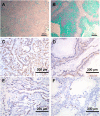Wnt pathway inhibition via the targeting of Frizzled receptors results in decreased growth and tumorigenicity of human tumors
- PMID: 22753465
- PMCID: PMC3406803
- DOI: 10.1073/pnas.1120068109
Wnt pathway inhibition via the targeting of Frizzled receptors results in decreased growth and tumorigenicity of human tumors
Abstract
The Wnt/β-catenin pathway, which signals through the Frizzled (Fzd) receptor family and several coreceptors, has long been implicated in cancer. Here we demonstrate a therapeutic approach to targeting the Wnt pathway with a monoclonal antibody, OMP-18R5. This antibody, initially identified by binding to Frizzled 7, interacts with five Fzd receptors through a conserved epitope within the extracellular domain and blocks canonical Wnt signaling induced by multiple Wnt family members. In xenograft studies with minimally passaged human tumors, this antibody inhibits the growth of a range of tumor types, reduces tumor-initiating cell frequency, and exhibits synergistic activity with standard-of-care chemotherapeutic agents.
Conflict of interest statement
Conflict of interest statement: All of the authors are employees of OncoMed Pharmaceuticals, which provided research funding. R.N. is a member of the OncoMed Scientific Advisory Board and holds stock in the company.
Figures






Similar articles
-
Frizzled Receptors in Tumors, Focusing on Signaling, Roles, Modulation Mechanisms, and Targeted Therapies.Oncol Res. 2021 Mar 16;28(6):661-674. doi: 10.3727/096504020X16014648664459. Epub 2020 Sep 30. Oncol Res. 2021. PMID: 32998794 Free PMC article. Review.
-
Targeting the Wnt pathway in human cancers: therapeutic targeting with a focus on OMP-54F28.Pharmacol Ther. 2015 Feb;146:1-11. doi: 10.1016/j.pharmthera.2014.08.005. Epub 2014 Aug 27. Pharmacol Ther. 2015. PMID: 25172549 Free PMC article. Review.
-
A novel humanized Frizzled-7-targeting antibody enhances antitumor effects of Bevacizumab against triple-negative breast cancer via blocking Wnt/β-catenin signaling pathway.J Exp Clin Cancer Res. 2021 Jan 12;40(1):30. doi: 10.1186/s13046-020-01800-x. J Exp Clin Cancer Res. 2021. PMID: 33436039 Free PMC article.
-
Inhibition of Wnt/β-catenin signaling by a soluble collagen-derived frizzled domain interacting with Wnt3a and the receptors frizzled 1 and 8.PLoS One. 2012;7(1):e30601. doi: 10.1371/journal.pone.0030601. Epub 2012 Jan 27. PLoS One. 2012. PMID: 22303445 Free PMC article.
-
Structure-based Discovery of Novel Small Molecule Wnt Signaling Inhibitors by Targeting the Cysteine-rich Domain of Frizzled.J Biol Chem. 2015 Dec 18;290(51):30596-606. doi: 10.1074/jbc.M115.673202. Epub 2015 Oct 26. J Biol Chem. 2015. PMID: 26504084 Free PMC article.
Cited by
-
Human T2D-Associated Gene IMP2/IGF2BP2 Promotes the Commitment of Mesenchymal Stem Cells Into Adipogenic Lineage.Diabetes. 2023 Jan 1;72(1):33-44. doi: 10.2337/db21-1087. Diabetes. 2023. PMID: 36219823 Free PMC article.
-
Sex-specific clinicopathological significance of novel (Frizzled-7) and established (MGMT, IDH1) biomarkers in glioblastoma.Oncotarget. 2016 Aug 23;7(34):55169-55180. doi: 10.18632/oncotarget.10465. Oncotarget. 2016. PMID: 27409829 Free PMC article.
-
Structural dynamics and inhibitor searching for Wnt-4 protein using comparative computational studies.Drug Des Devel Ther. 2015 Apr 29;9:2449-61. doi: 10.2147/DDDT.S79784. eCollection 2015. Drug Des Devel Ther. 2015. PMID: 25995617 Free PMC article.
-
Frizzled-7-targeting antibody (SHH002-hu1) potently suppresses non-small-cell lung cancer via Wnt/β-catenin signaling.Cancer Sci. 2023 May;114(5):2109-2122. doi: 10.1111/cas.15721. Epub 2023 Jan 19. Cancer Sci. 2023. PMID: 36625184 Free PMC article.
-
Chemoenzymatic Synthesis of Original Stilbene Dimers Possessing Wnt Inhibition Activity in Triple-Negative Breast Cancer Cells Using the Enzymatic Secretome of Botrytis cinerea Pers.Front Chem. 2022 Apr 19;10:881298. doi: 10.3389/fchem.2022.881298. eCollection 2022. Front Chem. 2022. PMID: 35518712 Free PMC article.
References
-
- van Amerongen R, Nusse R. Towards an integrated view of Wnt signaling in development. Development. 2009;136:3205–3214. - PubMed
-
- Wang Y. Wnt/Planar cell polarity signaling: A new paradigm for cancer therapy. Mol Cancer Ther. 2009;8:2103–2109. - PubMed
-
- James RG, Conrad WH, Moon RT. Beta-catenin-independent Wnt pathways: Signals, core proteins, and effectors. Methods Mol Biol. 2008;468:131–144. - PubMed
-
- Kohn AD, Moon RT. Wnt and calcium signaling: Beta-catenin-independent pathways. Cell Calcium. 2005;38:439–446. - PubMed
Publication types
MeSH terms
Substances
LinkOut - more resources
Full Text Sources
Other Literature Sources
Molecular Biology Databases

